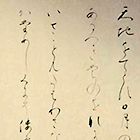Japanese Archaeology and Special Exhibition (Heiseikan) Thematic Exhibition Room
July 13, 2013 (Sat) - September 8, 2013 (Sun)
Japanese-style calligraphy (in Japanese, "wayo") is a style of calligraphy particular to Japan. This style was mainly established by Ono no Tofu, Fujiwara no Sari, and Fujiwara no Kozei, who are known as the "Three Distinguished Calligraphers" of the Heian period (794 - 1192). After the introduction of kanji characters to Japan from China, people in Japan were already studying Chinese calligraphy, such as works by Wang Xizhi. Through this study, Japanese-style calligraphy developed in response to the tastes of Japanese people. Tokyo National Museum's current special exhibition, The Beauty of Japanese-style Calligraphy, introduces masterpieces of Japanese-style calligraphy from a period up to the Edo period (1603 - 1868), with a focus on Heian-period works.
In the Meiji era (1868 - 1912), owing to new projects undertaken after the Meiji Restoration, such as the establishment of a national museum (the forerunner to this museum), calligraphy came to be treated differently in society. The Japanese-style calligraphy that had spread in the Edo period as calligraphy taught by the Oie-ryu school began to be regarded as a part of education, as well as modern cultural properties and art. In 1880, with the visit of Yang Shoujing to Japan from China, Chinese-style calligraphy in Japan also developed in new directions. Furthermore, in 1890 the Naniwazu-kai study group was formed, through which people began researching Heian-period kana characters. In this way, from the Meiji era onward, students of Japanese-style calligraphy focused on kana characters, and, while studying classic texts, continued to produce new calligraphic works.
The Tokyo National Museum collection includes many calligraphic works from the modern era in Japan (Meiji era onward). This exhibition displays some of these works, with a focus on examples featuring kana characters.

